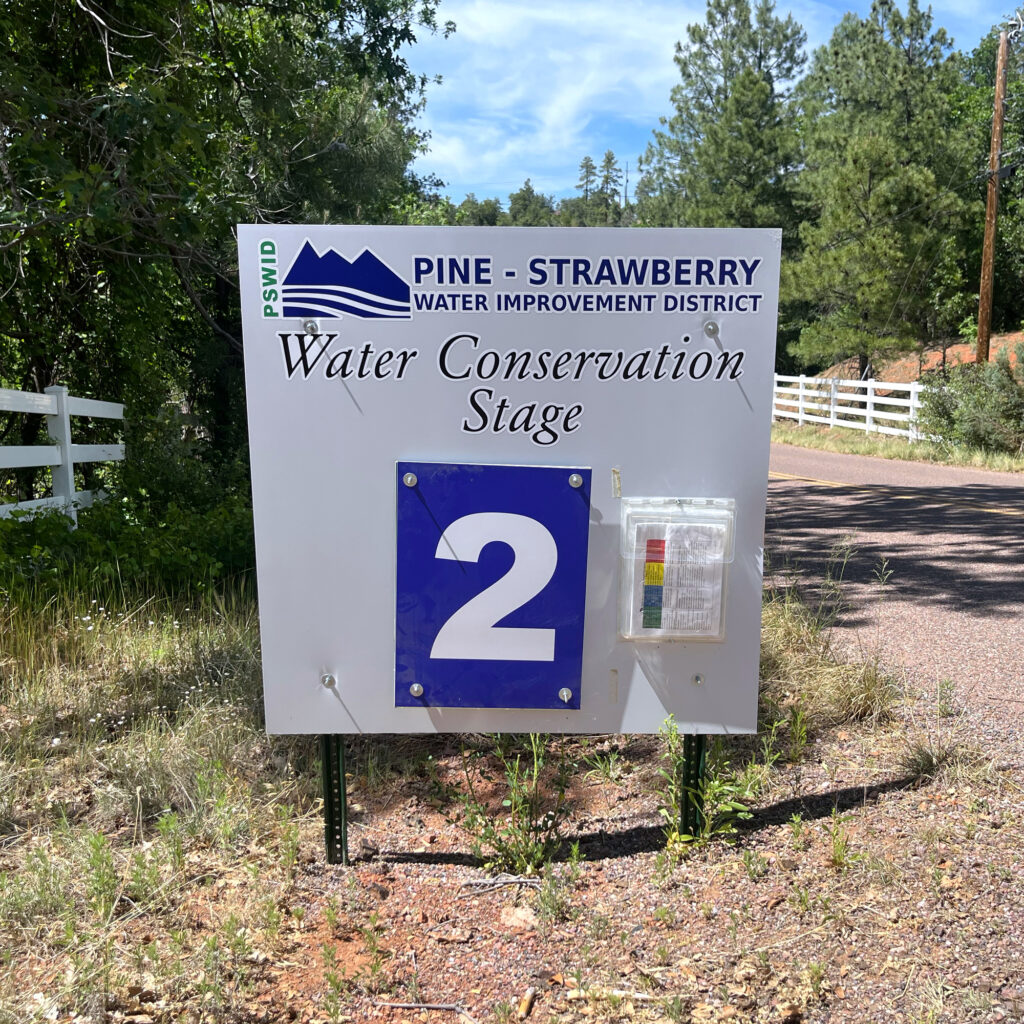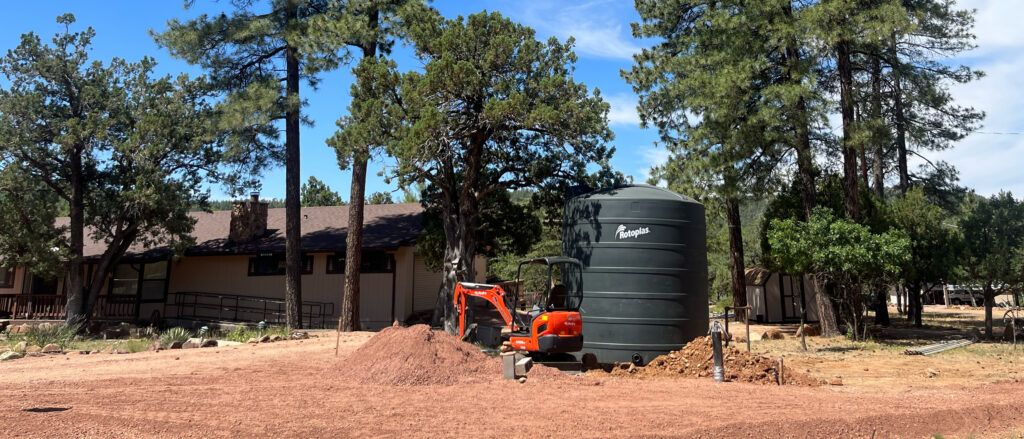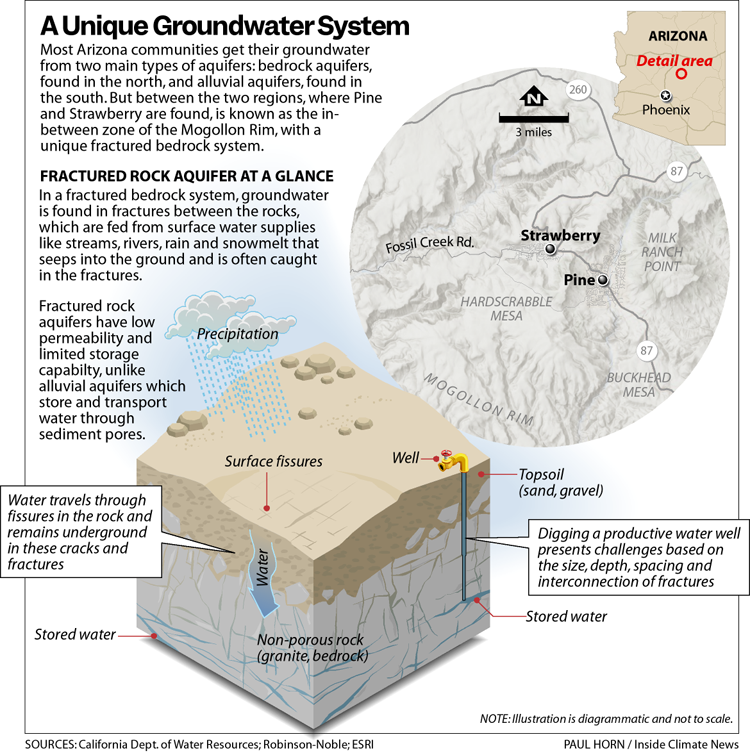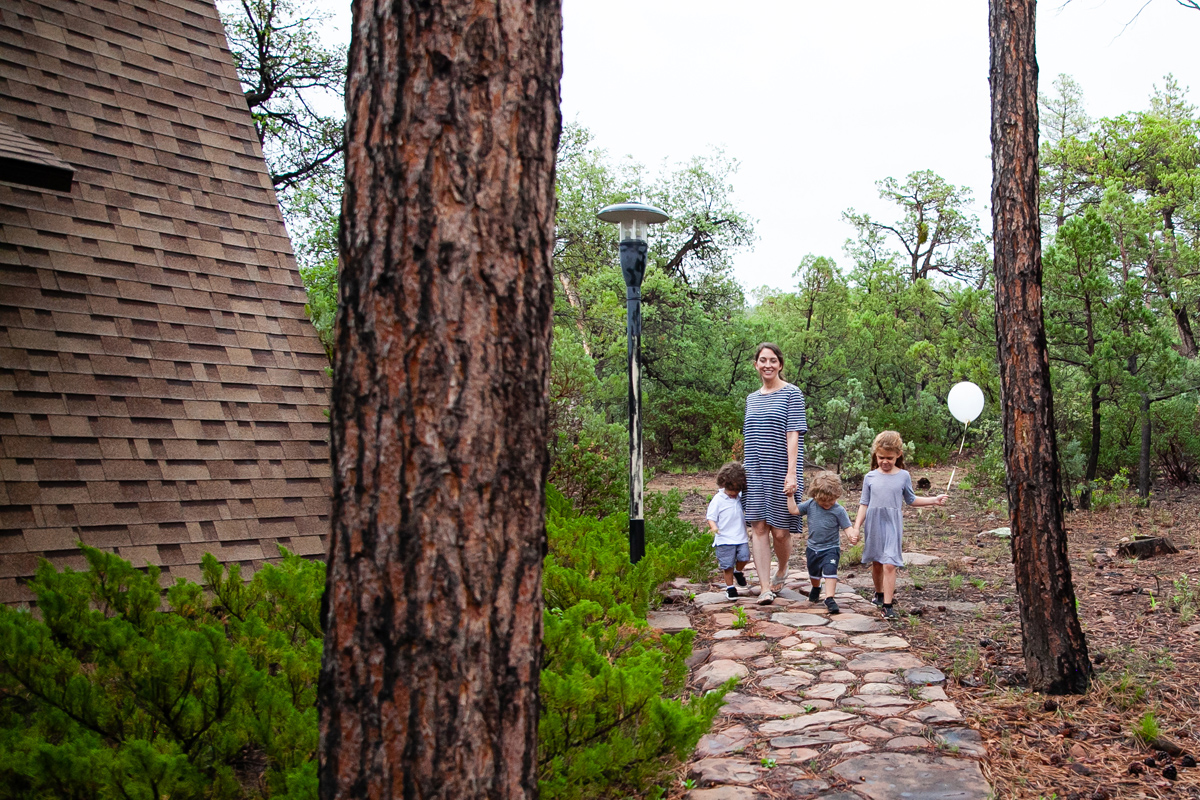A Rural Arizona Water District Had a Plan to Keep the Supply Flowing to Its Customers. They Sued
STRAWBERRY, Ariz.—Nearly two years ago, officials with the Pine-Strawberry Water Improvement District seemed on the verge of finding a solution to their water woes.
Located between Phoenix and Flagstaff, the water infrastructure of these two rural unincorporated communities of roughly 3,000 in Gila County was failing. Wells constructed by ranchers decades ago and sold to the water district were failing from age and poor construction, and over a third of the water they pumped from the ground leaked from the aging pipes. Concern over the area’s water supply had been documented for decades. Studies showed that in the summer months, when Phoenix area residents head to the mountains around Strawberry and Pine to escape the hottest major city in the country, surging the community’s population to 8,000 and doubling the amount of water required by its residents, the district couldn’t meet demand on its thirstiest day. And in 2021, the district issued a moratorium on issuing any new water meters for the community, effectively killing future growth.
The issue was framed as one brought on by the drought that had gripped the Southwest for two decades, and the water district worked to secure federal funding to fix its crumbling infrastructure. It spent millions fixing leaky pipes and failing wells.
Explore the latest news about what’s at stake for the climate during this election season.
But if the community was to grow, it needed a new, more reliable source of water. In Pine-Strawberry, the community, like many rural areas around the country, is entirely reliant on groundwater, and the easiest solution would be to drill a new deep well. A hydrologist identified multiple locations they could choose from, but the district’s board members determined they were too expensive and would be too difficult to build on.
Instead, the water district bought a house in a subdivision and in the summer of 2023, began digging a new deep well.
Then its customers sued the district.
“There was no case made on why they need this. They just sort of went and did it.”
The only notice neighbors of the project received about the plan came after the site’s trees had been cut down and the well’s construction got started. Locals of the subdivision were left to figure out for themselves what was happening, and what the local water district thought was a simple plan to drill a new well turned into a lawsuit in which a judge ruled its construction must stop, the water district beginning the process of using eminent domain to continue pursuing its work, a recall election for the district’s board and a community uncertain of its water future.
“They did zero public outreach. There was no public discussion on this,” said David Diggs, a homeowner of the subdivision who joined the lawsuit against the water improvement district. “There was no case made on why they need this. They just sort of went and did it. And as smart as they are, I like to think that the collective intelligence of the community would be even smarter to try to figure this out going forward. You kind of need to build community support for these projects, and this group has just kind of gone rogue.”
The Questions
No one in the community is against having a good supply of water, said Dave Cady, a Strawberry resident who also was part of the lawsuit. After all, this is Arizona, he said. Rather, they are opposed to the lack of community engagement and communication for the project. “They’re beating themselves to death trying to justify it,” he said.
At the heart of it all were simple questions residents felt were left unanswered: What was the condition of the local aquifer—the community’s only source of water? How was the worst drought the Southwest has seen in 1,200 years impacting the Pine-Strawberry community? Why did the district choose to drill the deep well in the middle of a subdivision and not somewhere away from people’s homes?

A review of state groundwater data shows water levels have remained relatively stable in the region, though data in Strawberry itself is limited. And while the board initially framed the water issues they are responding to as driven by drought, members have taken a different stance in more recent public meetings.
“It’s not about a drought. It’s not about wells going dry,” said George Gorkowski, vice chairman of the board in a 2023 public meeting about the moratorium. “It’s about we have a finite amount of wells that put out a finite amount of gallons per minute and we have a finite amount of people adjoined to them. We’re really talking more of a system issue, than we are a case where we got wells drying up and water’s going away.”
The ensuing fallout has left the local community uncertain of the condition of its water supply, and if an expensive deep well to accommodate future growth is necessary if existing but failing water infrastructure was repaired. The debacle also serves as an example of how messy and complicated plans to address water shortages in drought-stricken Arizona can become as millions of dollars are earmarked to address such problems across the state.
Cory Ellsworth, the chairman of the Pine-Strawberry Water Improvement District, said the district recognizes it failed to communicate the details of the project to the community, but noted they didn’t think the site of the deep well would be an issue as the home already has a more shallow well the district had been pulling water from for years. The site made the most sense, he said, as others identified were more expensive and would have been challenging for the contractors to build on.

The lawsuit made it difficult to have discussions with the community about the decision, he said.
If the board could go back in time, he added, they would handle the situation differently, but ultimately they don’t regret the site choice or the plan for a deep well.
“The right things are being done for the right reasons,” Ellsworth said. “Do we always get it perfectly right? For sure, not. But we’re just trying our best.”
The Aquifer
Nestled between the Colorado Plateau of northern Arizona and the Sonoran desert in the state’s southern half, the Mogollon Rim has become famous for its views. It’s home to Pine and Strawberry, with their endless rows of Ponderosa pines, and the iconic city of Sedona backdropped by famous red rock formations.
It’s also home to aquifers unlike any others in Arizona—or the lack of them.
In the northern end of the state, bedrock aquifers are made up of rocks like those found in the region’s iconic canyonlands—like the Grand Canyon—that have porosity, meaning water can pass through them and be stored. In places like Phoenix, groundwater is found in alluvial aquifers, where the basins are filled with unconsolidated materials like sand, gravel and clay that water can seep between.
The Mogollon Rim is instead composed of a fractured bedrock system that provides no water storage in the traditional sense. Instead, the scarce resource is found in fractures between the rocks that are fed from surface water supplies like streams, rivers, rain and snowmelt that seeps into the ground and is often caught in the fractures.

If a well isn’t drilled into one of the fractures, it won’t hit water. Drilling as deeply as possible at the intersection of two or more fractures gives the greatest odds of tapping a significant supply. “The primary porosity of these rocks is generally inadequate for storage and conveyance of appreciable amounts of groundwater,” a well siting report conducted for the water improvement district in 2022 stated. “That is to say, the void spaces between sediment grains in
these rocks are insufficient alone to constitute acceptable aquifer conditions. Rather, those conditions are provided by secondary porosity from joints, fractures, and faulting in these rocks.”
The study conducted a fracture trace analysis, which maps the breaks in the ground that water can fill in to make up the region’s “shallow aquifers.”
According to the report, a well deeper than 1,300 feet would encounter another aquifer in carbonate rocks, like the Redwall Limestone found along the walls of the Grand Canyon, that would provide a reliable supply of groundwater.
So for a new deep well, the report mapped five locations where multiple fractures intersected to provide shallower groundwater and deeper drilling would reach the second aquifer.
Ellsworth, the chairman of the Pine-Strawberry Water Improvement District, said the water district evaluated those site locations, but ultimately they were not suitable because of the price or the difficulties they would encounter during construction. They settled on the Strawberry location, as it was for sale and the district already pulled water from the shallow well located on the property. That site also made sense because more wells had failed in Strawberry than Pine, leading Pine to send water to Strawberry.
“I don’t know that the idea of putting another well on that property and having a storage tank jumped off the page as something that needed to be carefully orchestrated with the community,” he said.
However, locals of the subdivision quickly pushed back once they learned of the plan and realized that the Pine-Strawberry Water Improvement District had done no public outreach. A former member of the district’s board of supervisors who was involved in the deep well site selection process before resigning said he had warned the board members that proceeding without community outreach would cause issues, though he has no problem with the location itself and recognizes a more reliable source of water is vital for the community’s future.
“They’d already purchased the property, and they were, you know, damn the torpedoes and full speed ahead. They don’t care what anybody thinks. ‘We’re the water district, we can do whatever we want,’” said Tom Reski, the former supervisor, who has since tried to mediate the tensions over the deep well’s location. “ I told them ‘We’re going to get our asses sued. Mark my words, we’re going to get sued over this.’”
The Litigants
Since the judge ruled construction on the deep well must stop, two excavators have sat quietly in front of the house where it was being drilled, surrounded by piles of dirt, fencing and long pipes.
Across the street is Tiffany Halperin’s home. Her grandfather purchased the land in the early 1970s, along with its well, and then spent the following years building a cabin that the family could visit during the summer and gather at for holidays and celebrations, as do many families who have purchased land in Strawberry. Eventually, the cabin became Tiffany’s responsibility, and during the Covid-19 pandemic, she moved her family there full time to escape the crowds of the city and give her children the rural experiences she had as a child.
Her main worry, however, was water, and she didn’t want to devote time and money to fixing up the property if the community was going to run out of it.
When she spoke to many of her neighbors, “it sounded like any second you would turn the faucet on and the water would run out,” Halperin said. But when she went to the water district’s board of supervisors’ meetings, “there wasn’t that sense of urgency.”
Then one weekend, she arrived at the cabin to see tractors had uprooted the trees around the house across the street. Halperin asked around and eventually learned the home had been purchased by the water district and was to be the site of the new deep well. So she began knocking on her neighbors’ doors to see if anyone had been notified of the project. “Nobody knew who bought the property,” she said. “I was the first to inform them.”

Halperin’s day job is in urban design and architecture and is used to designing projects and working with communities, which left her shocked no one had been notified. Neighborhood meetings were not fruitful, leading Halperin and some of her neighbors to hire a lawyer to stop the construction of the deep well. At the time, the water district’s lawyer said in a letter that a lawsuit would be “a futile waste of money.” But in the end, a judge ruled the district had violated the neighborhood’s zoning declarations, and ordered the water district to pay the neighbors’ legal fees.
Given the project’s label as a “deep well,” the neighbors were concerned it would outcompete their own properties’ wells, as well as others in the nearby area the water district used. Reports commissioned by the water district cautioned that if a deep well was to be drilled, it should be located away from other wells.
That’s a valid concern for other types of aquifers, like in Phoenix, where wells can create a cone of depression, drawing down the water table near it and potentially impacting other, shallower wells nearby. Hydrologists say the fractured bedrock system found in Strawberry doesn’t pose that same risk. But that was never clearly communicated with neighbors who were largely unaware of how the groundwater below Strawberry differs from most other aquifers found in the state.
The district’s board of supervisors in June unanimously voted to allow its attorneys “to take all actions and spend all funds necessary or convenient to extinguish any encumbrances, restrictive covenants, restrictions, easements or other limitations concerning the use of Lot 26”—the site of the deep well—and pursue eminent domain to bypass the property’s zoning. The language prompted pushback from the community during that hearing, with those in attendance saying it was an overreach of the board’s authority.
Ellsworth, the chairman of the board, said the district still intends to complete the project and plans to better communicate with the community.
“We’re gonna spruce that up to be the prettiest place in the neighborhood and will appropriate the dollars to make that happen and to get things planted’” he said. “The community is just going to have to take that on faith, but that has always been our intent.”
About This Story
Perhaps you noticed: This story, like all the news we publish, is free to read. That’s because Inside Climate News is a 501c3 nonprofit organization. We do not charge a subscription fee, lock our news behind a paywall, or clutter our website with ads. We make our news on climate and the environment freely available to you and anyone who wants it.
That’s not all. We also share our news for free with scores of other media organizations around the country. Many of them can’t afford to do environmental journalism of their own. We’ve built bureaus from coast to coast to report local stories, collaborate with local newsrooms and co-publish articles so that this vital work is shared as widely as possible.
Two of us launched ICN in 2007. Six years later we earned a Pulitzer Prize for National Reporting, and now we run the oldest and largest dedicated climate newsroom in the nation. We tell the story in all its complexity. We hold polluters accountable. We expose environmental injustice. We debunk misinformation. We scrutinize solutions and inspire action.
Donations from readers like you fund every aspect of what we do. If you don’t already, will you support our ongoing work, our reporting on the biggest crisis facing our planet, and help us reach even more readers in more places?
Please take a moment to make a tax-deductible donation. Every one of them makes a difference.
Thank you,
David Sassoon
Founder and Publisher
Vernon Loeb
Executive Editor
Share this article
Disclaimer: The copyright of this article belongs to the original author. Reposting this article is solely for the purpose of information dissemination and does not constitute any investment advice. If there is any infringement, please contact us immediately. We will make corrections or deletions as necessary. Thank you.
Title:A Rural Arizona Water District Had a Plan to Keep the Supply Flowing to Its Customers. They Sued
Url:https://www.investsfocus.com








